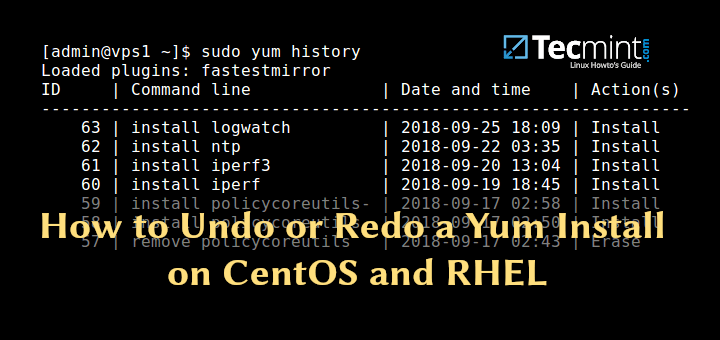Name
yum-complete-transactionEtron usb devices driver download for windows 10. 2)Reboot the workstation in the new kernel 3)Do a yum clean all, followed by a yum -y update. If there are any problems, yum should complain about unfinished transactions on step 3. In that case, you could also issue a yum-complete-transaction between steps 2 and 3.
- If there are more unfinished transactions, yum-complete-transaction attempts to complete the most recent one first. To clean transaction journal files without attempting to resume the aborted transactions, use the -cleanup-only option: yum-complete-transaction-cleanup-only.
- Dear list members, I have questions regarding yum-complete-transaction: When updating/applying new updates, I see a message please run yum-complete-transaction, and I.
- Maybe it could also help to do a yum clean all, you might need to run yum-complete-transaction afterwards. Also just installing the RPM with rpm -Uvh your-rpm-file.rpm might give you more insight. Improve this answer. Follow answered Dec 14 '10 at 10:56.
Synopsis
yum-complete-transaction [options]General Options
Files
As yum-complete-transaction uses YUM libraries for retrieving all the information, it relies on YUMconfiguration for its default values like which repositories to use. Consult YUM documentation for details:See Also
Authors

Yum-complete-transaction As Root
Bugs
There are of course no bugs, but should you find any, you should first consult the FAQ section onhttp://yum.baseurl.org/wiki/Faq and if unsuccessful in finding a resolution contact the mailing list: yum-devel@lists.baseurl.org. To file a bug usehttp://bugzilla.redhat.com for Fedora/RHEL/Centos related bugs and http://yum.baseurl.org/report for all other bugs.Referenced By

Introduction

Files
As yum-complete-transaction uses YUM libraries for retrieving all the information, it relies on YUMconfiguration for its default values like which repositories to use. Consult YUM documentation for details:See Also
Authors
Yum-complete-transaction As Root
Bugs
There are of course no bugs, but should you find any, you should first consult the FAQ section onhttp://yum.baseurl.org/wiki/Faq and if unsuccessful in finding a resolution contact the mailing list: yum-devel@lists.baseurl.org. To file a bug usehttp://bugzilla.redhat.com for Fedora/RHEL/Centos related bugs and http://yum.baseurl.org/report for all other bugs.Referenced By
yum-utils(1)Introduction
The yum package manager maintains a history of all yum based transactions i.e. software installation, update and removal operations. This history is kept in an sqlite database (rpmdb) which is available in the /var/lib/yum/history/ directory. Fravega driver download for windows. The transaction history in the rpmdb can be queried via the yum history command. We would also like to point out that a log of package installs, updates and removals is maintained in a text file as well located at /var/log/yum.log. The file provides one line descriptions about the yum related actions that were performed. But a very interesting facet of the yum transaction history is that transactions can be repeated and reversed and also incomplete transactions can actually be resumed. In this article we'll be focusing on how we could resume incomplete yum transactions and complete them to fruition.
Demonstration
With a basic understanding of how yum transactions are maintained, let's perform a practical demonstration of how we could resume an incomplete yum transaction. Consider the following operation, we are just installing the openssl package on our system. What if during the installation we loose our network connectivity. This is just a single package so repeating the installation isn't challenging but if it were an entire system update then redoing the entire task from scratch would be tedious. To simulate an interruption I hit the ctrl+c key to stop the yum package installation.
The log containing the progress of the above interrupted transaction has been saved in /tmp in a file named yum_save_tx.2018-03-02.12-34.RZUTa5.yumtx. This file is a simple text file and we can view it's contents as shown below.
To resume the transaction we use the load-transaction sub-command with the yum command followed by the complete path to the .yumtx file. Ems production driver download.
It might not seem obvious from the above command line output but the openssl package installation actually resumed exactly from where I had left it off. If you wish to check if the system has any incomplete transactions and complete them then use the yum-complete-transaction command.
To only cleanup incomplete transactions without resuming them, use the following command.
Conclusion
This concludes our demonstration of how we could use yums' transaction history feature to resume incomplete transactions. We hope that you've found this demonstration to be useful and we look forward towards your feedback.
The following two tabs change content below.Yum-complete-transaction Loop
- Google Cloud basics: Activate Cloud Shell - May 19, 2021
- Create persistent swap partition on Azure Linux VM - May 18, 2021
- DNF, YUM and RPM package manager comparison - May 17, 2021
- Introduction to the aptitude package manager for Ubuntu - March 26, 2021
- zypper package management tool examples for managing packages on SUSE Linux - March 26, 2021
